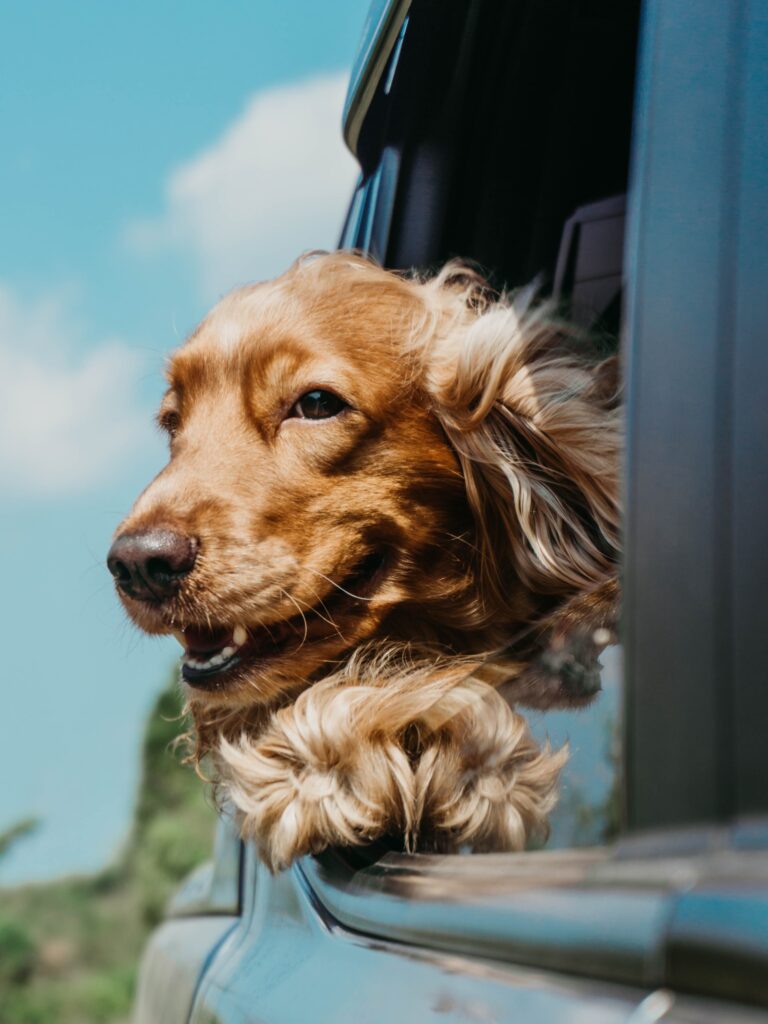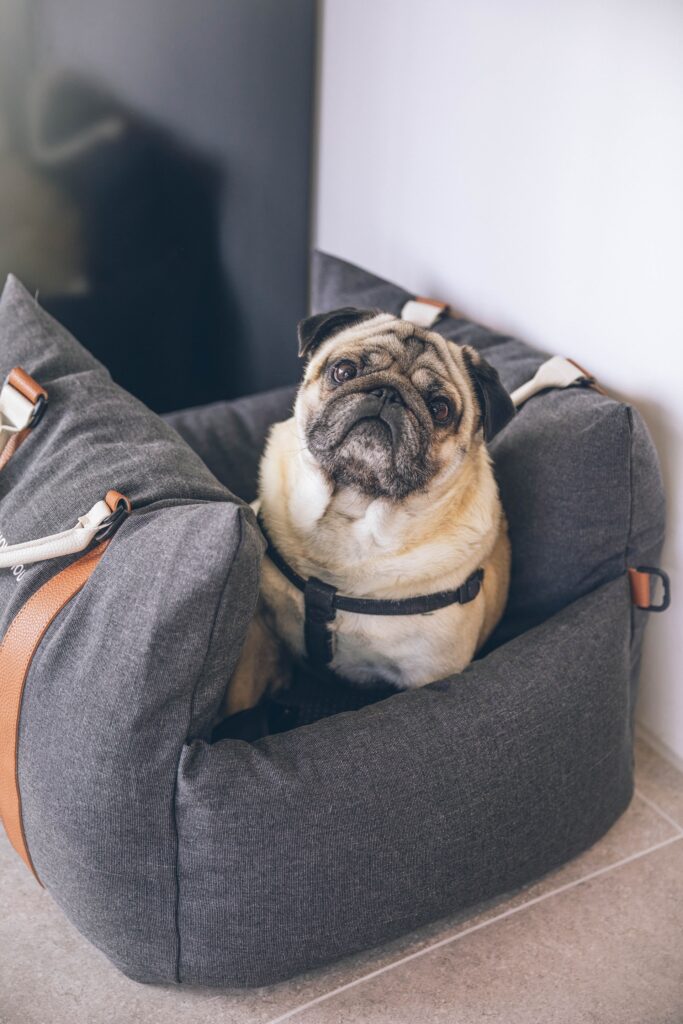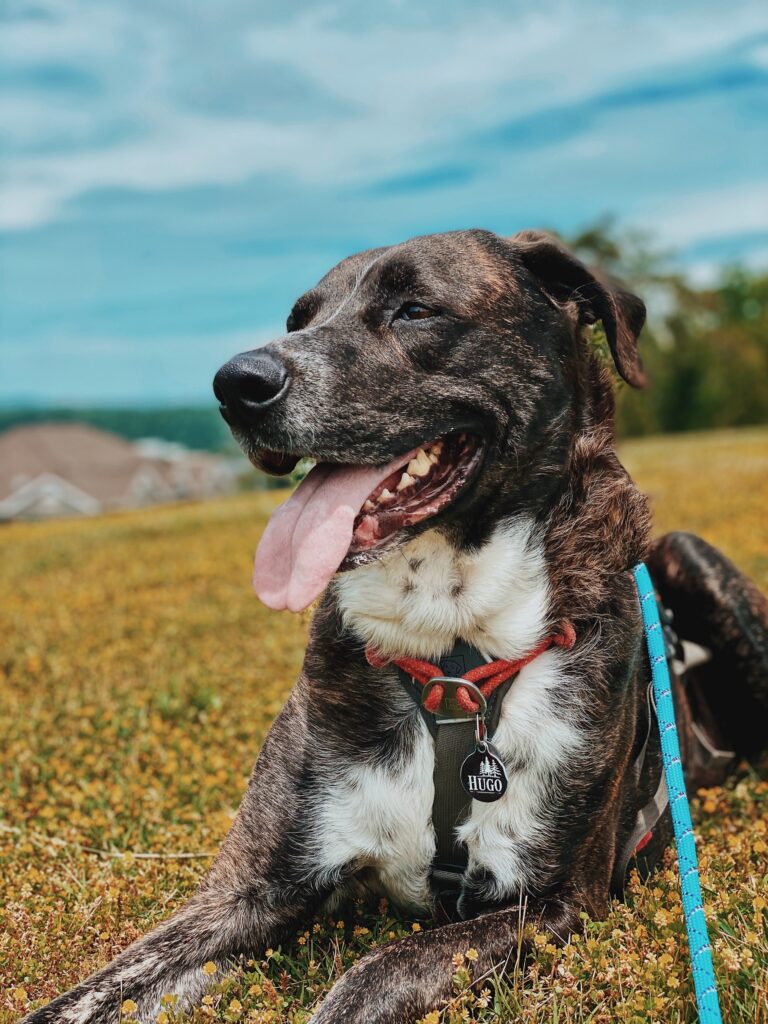Planning a car ride with your dog can be so much fun and at the same time cause serious concerns. Safety is important but how to know if all the safety measures are taken care of? And what does the law say about dog’s safety in the car?
Let’s go over the basics so you can have more peace of mind and enjoy your trip with your furry family member!
The law about dog’s safety in the car
We are all responsible drivers and dog owners so it’s our job to drive safely, limit any distractions in the car and look after our doggos safety, right? Yes, thank you. Even though the law is a little different depending on the country, when it comes to transporting our dogs, we should always obey this rule.
UK has a law about dogs in the car in The High Way Code 57, which states: “When in a vehicle make sure dogs or other animals are suitably restrained so they cannot distract you while you are driving or injure you, or themselves, if you stop quickly. A seat belt harness, pet carrier, dog cage or dog guard are ways of restraining animals in cars.”
In Europe, Citizen Advice Organisation says: “The dogs should be secured in harnesses, attached to seat belt sockets on the back seat, or in crates either behind front seats or in the case of bigger dogs in secured crates in the boot of the car.”
Let’s go over what all of that means.

Different safety methods to fasten your dog during car rides
“Suitably restrained so they cannot distract you while you are driving or injure you, or themselves –” is quite clear. You need to make sure your dog can’t move so much so that they could distract you while you drive. “– A seat belt harness, pet carrier, dog cage or dog guard are ways of restraining animals in cars.” We will check all the different methods on how you can restrain your dog safely and make them feel comfortable in the car.
Seatbelt for dogs
A seat belt harness is two separate things in one: a harness and a seat belt for dogs. The harness part can be any harness that is comfortable for your dog and stays safely on. I would recommend using a harness that you can use during walks as well. It’s too much of a hassle to change your dog from one “car harness” to another. They’re the same.
You can find a harness and a seat belt for dogs together or separate so you can choose a dog harness print you like and just attach it to a universal dog seat belt. The seatbelt for dogs has a seat belt buckle on the other end and on the other end is a hook latch. You can fasten your dog’s harness to this hook. For a large dog, there are also longer seat belts.

Difference between a dog carrier and a dog crate
Pet carriers or dog carriers are those softer, usually fabric carriers that have zippers, and your dog can see through the mesh. They are durable, lightweight, and more often waterproof polyester fabric. These are really comfortable and you can find ones that you can fold smaller when you don’t use them. Really handy, easy, and safe!
Dog cages or crates are usually metal all over, have two doors and they can be folded as well. Dog cages and crates have a plastic cover protecting the floor so it’s more comfortable and you can put a fabric bed, pillows, or towels on top of – whatever your doggo prefers to sleep on. When you fold the crate or the dog carrier, you should be able to fold them in less than a minute and you don’t need any tools.

If your dog has never been on a carrier, cage, or crate, it’s good to put it in the living room or your bedroom first. When your dog gets used to it and falls asleep in there, it’s really easy to place it in the car. It should be a place where your dog feels safe and comfortable so you should never use it as a place of punishment. If your dog is hesitating at the beginning, you can place your dog’s favorite toys in there or some treats and give it time.
Dog barrier for the car
A dog barrier or a guard is a safety feature to secure the back area and to keep your dog out of the front seat area. A dog barrier can be made of different materials and you can adjust them freely to fit your backseat area.
The dog barrier itself isn’t enough to keep your dog safe in the car. If the dog isn’t in a harness and seatbelt, the movement of the car is too much and your dog will slide in the back seat and wouldn’t be considered suitably restrained. The dog barrier is more like a double-safety-feature. It’s not necessary and it’s not enough on its own. You decide.
10 dog safety tips for car rides
- Dogs should sit behind the front seats with a harness and attached to a seat belt socket. Bigger dogs should be in secured crates in the boot of the car.
- It’s good to have a harness that you can use for walks as well. It will be easier on you and on your dog. You should be able to attach any harness with a seat belt buckle meant for dogs.
- Dog crates come with different materials. Soft travel crates are more comfortable for your dog. Pick one that you can easily fold.
- Remember to give your dog a few hours after a meal before hitting the road. This will reduce travel sickness.
- Dog car seat protector cover with a seat belt is a great way to keep your dog safe and your car cleaner.
- If your dog isn’t used to long rides, take a little break every few hours. Let your dog walk around a little and give your dog a chance to drink.
- Car net barriers give you extra safety if you use a harness and a seat belt. The barrier keeps your dog’s curious nose away from your ears.
- A portable car seat with a clip-on safety leash is comfy and safe for small dogs. Just make sure to fasten your dog to the car seat.
- Keep some organic wet wipes, eco-friendly poop bags, and a first aid kit close by.
- Have some snacks with you and wet food that you can give your dog when you arrive at your destination.

Do dogs enjoy car rides
Many dogs enjoy car rides when they get used to being in that giant moving machine. Car rides allow dogs to explore new sounds, smells, and sites. How exciting! There’s a different atmosphere in the air, they can be close to their pack and usually, car rides mean there’s something enjoyable when everyone gets out of the moving machine.
Some dogs even fall asleep fast when they get used to being in a car. That’s because they know nothing’s going to happen before the car stops and people get out. So they will just relax, enjoy the soft movement of the car and familiar smells of the beloved pack leader, you.
Why do some dogs hate car rides
Commonly, some dogs might be uneasy being in a car or even going into a car voluntarily. It’s important to go easy with the first steps. If your dog has never been in a car or you have a rescue doggo and think it might be the doggo’s first time – you can start with just opening the car door and closing it. Give your dog some ‘good boy’ praises and some treats. Then you can start putting treats in the car so your doggo can reach them by putting front paws into the car. One step at a time.
Don’t force your dog because they can become afraid of the car because of that experience.
Also if the car rides only end up in the vet’s office, dogs will associate car rides with something unpleasant even if they don’t remember what that unpleasant thing was. That’s how the dog’s memory is wired. If you can, go to the dog park or somewhere your dog enjoys, just once in a while between vet visits.

How long can you drive with a dog in the car
Car rides aren’t bad for your dog if your dog is used to being in a car. Because some dogs love car rides and others aren’t keen on them, you should plan your trip accordingly. If your dog loves car rides, you can make your dog’s journey more comfortable by adding favorite toys, fluffy pillows, or whatever your dog likes to sleep on.
If your dog doesn’t really like car rides now it doesn’t mean that your dog wouldn’t even like them. In this case, take more breaks along the way and a long walk to wear your dog out before leaving. That way your dog can fall asleep more quickly when nothing is happening in a car.
It’s good to give your dog a few hours or more after eating before packing your dog in the car. This will avoid car sickness. Go for a long walk as well if you can so you don’t have to clean up any unnecessary mess in the car.
Few hours is a good rule of thumb when you hit the road as well: plan your long car ride so that there’s plenty of stops along the way. Your dog might be okay with more than two-hour periods but if you are not sure, stop every few hours. Let your dog smell the surroundings and offer some water. These stops don’t have to last long. Fresh air between a few hours is good for you as well if you are not used to long car rides.
Conclusion
We always need to limit any distractions in the car and look after our doggos safety. By estimating your dog’s needs in the car (crate, harness, seatbelt) and taking necessary stops along the way, you will have an enjoyable and safe journey.
Before leaving it’s smart to get your dog used to be in a harness or in a crate. You can go and take walks in the new harness or leave the crate in the living room filled with your dog’s favorite toys and treats – always considering the crate to be the dog’s happy place. Then move slowly and take shorter car rides to places you would think your dog really enjoys. Making those good associations that car rides mean something really nice.